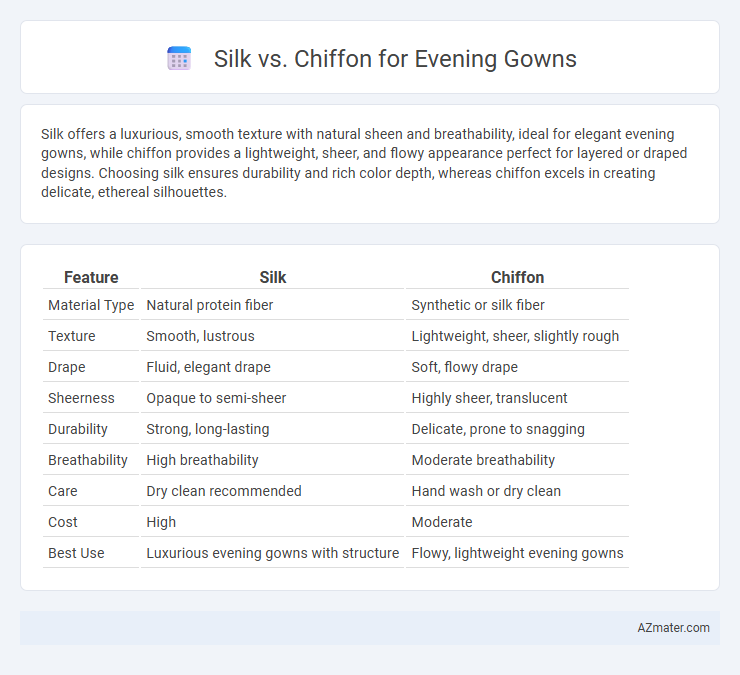Silk offers a luxurious, smooth texture with natural sheen and breathability, ideal for elegant evening gowns, while chiffon provides a lightweight, sheer, and flowy appearance perfect for layered or draped designs. Choosing silk ensures durability and rich color depth, whereas chiffon excels in creating delicate, ethereal silhouettes.
Table of Comparison
| Feature | Silk | Chiffon |
|---|---|---|
| Material Type | Natural protein fiber | Synthetic or silk fiber |
| Texture | Smooth, lustrous | Lightweight, sheer, slightly rough |
| Drape | Fluid, elegant drape | Soft, flowy drape |
| Sheerness | Opaque to semi-sheer | Highly sheer, translucent |
| Durability | Strong, long-lasting | Delicate, prone to snagging |
| Breathability | High breathability | Moderate breathability |
| Care | Dry clean recommended | Hand wash or dry clean |
| Cost | High | Moderate |
| Best Use | Luxurious evening gowns with structure | Flowy, lightweight evening gowns |
Introduction: Silk vs Chiffon for Evening Gowns
Silk and chiffon are popular fabric choices for evening gowns, each offering unique qualities that influence the garment's elegance and comfort. Silk provides a luxurious, smooth texture with a natural sheen, ideal for a sophisticated and polished look, while chiffon offers a lightweight, sheer finish that adds softness and fluidity. Selecting between silk and chiffon depends on the desired gown silhouette, drape, and overall aesthetic for formal occasions.
Defining Silk and Chiffon Fabrics
Silk is a natural protein fiber known for its smooth texture, durability, and luxurious sheen, often used in evening gowns for its elegant drape and rich appearance. Chiffon is a lightweight, sheer fabric typically made from silk, polyester, or nylon, characterized by its delicate, airy feel and slightly rough texture that adds softness and movement to formal wear. The choice between silk and chiffon impacts the gown's flow, weight, and overall sophistication, with silk offering a heavier, lustrous finish and chiffon lending a light, ethereal quality.
Texture and Feel: Silk Compared to Chiffon
Silk offers a smooth, luxurious texture that feels soft and cool against the skin, making it ideal for evening gowns requiring elegance and comfort. Chiffon has a lightweight, sheer, and slightly rougher texture, providing a delicate and airy feel that adds ethereal movement to formal wear. Silk's natural sheen contrasts with chiffon's matte finish, enhancing the gown's overall silhouette and tactile experience.
Visual Appeal: Sheen, Drape, and Transparency
Silk offers a luxurious sheen and smooth drape that creates an elegant silhouette, enhancing the evening gown's sophisticated appeal. Chiffon provides a lightweight, airy texture with a semi-transparent quality, adding softness and movement to the design. The subtle gloss of silk contrasts with chiffon's matte finish, making each fabric uniquely suited to different visual aesthetics in evening wear.
Comfort and Breathability in Evening Wear
Silk offers a luxurious softness and excellent breathability, making it highly comfortable for evening gowns, especially in warmer settings. Chiffon, while lightweight and airy, provides a sheer and flowy texture that enhances ventilation but may require layering, which can affect overall comfort. Both fabrics excel in elegance, but silk generally delivers superior smoothness and temperature regulation for extended wear.
Durability and Care Considerations
Silk evening gowns offer a luxurious feel with moderate durability, requiring gentle hand washing or professional dry cleaning to maintain their sheen and prevent damage. Chiffon, often made from polyester or silk blends, provides lightweight elegance but is more prone to snagging and requires delicate care, including hand washing in cold water or dry cleaning. Choosing between silk and chiffon depends on balancing the desired fabric longevity with the commitment to proper maintenance and care.
Color Options and Dyeing Qualities
Silk offers a rich, vibrant palette due to its natural protein fibers that absorb dyes intensely, resulting in deep, luxurious hues ideal for evening gowns. Chiffon, typically made from silk or synthetic fibers, provides softer, more translucent color options that create ethereal, layered effects but may exhibit less color saturation. The dyeing process for silk allows for long-lasting, colorfast finishes, while chiffon's open weave can lead to more subtle color variations and a delicate, airy aesthetic.
Suitability for Different Evening Gown Styles
Silk offers a luxurious, smooth texture ideal for structured evening gowns such as mermaid or sheath styles, giving a sleek and elegant silhouette. Chiffon's lightweight and sheer quality makes it perfect for flowing, layered, or A-line evening gowns, creating a soft, ethereal look with graceful movement. Designers often choose silk for formal, fitted gowns, while chiffon enhances romantic or bohemian styles due to its drape and translucency.
Price Comparison and Value for Money
Silk evening gowns typically command higher prices due to the natural fiber's luxurious texture and durability, often ranging from $300 to $1,500. Chiffon gowns, usually made from polyester or nylon blends, are more affordable, with prices between $100 and $500, making them accessible for budget-conscious buyers. Considering value for money, silk offers longevity and a premium feel ideal for formal occasions, while chiffon provides an elegant, lightweight alternative that is cost-effective but may lack the same durability.
Choosing the Right Fabric: Silk or Chiffon?
Silk offers a luxurious sheen and smooth texture that enhances evening gowns with elegance and drape, making it ideal for structured designs or formal settings. Chiffon provides a lightweight, sheer quality that creates ethereal layers and flowing silhouettes, perfect for soft, romantic looks. Choosing between silk and chiffon depends on the desired gown's formality, silhouette, and comfort, with silk excelling in richness and chiffon in breathability and movement.

Infographic: Silk vs Chiffon for Evening Gown
 azmater.com
azmater.com